The Bens' bird camp blog
The (BTO) annual Bird Camp brings enthusiastic young naturalists together to enjoy a packed two-day extravaganza celebrating birds and wildlife. Held over the Bank Holiday weekend at the end of May, this event is a real highlight of the year for BTO staff and participants alike. Supported generously by the , attendants gain a valuable insight into scientific surveys such as the BTO’s and ringing survey, whilst meeting other like-minded youngsters and learning bird ID tips, calls and songs and interacting in a friendly group environment.
This year young birders Ben Porter and Ben Moyes, volunteered alongside BTO staff to help lead the camp. Ben P is an undergraduate, and Ben M is doing his A Levels. Here they describe their experiences of the weekend.
Ben P
Whilst I hadn’t previously attended this brilliant event, I had seen blog posts and manifestos on those from previous years, and was keen to get involved. Being a passionate birder and wildlife enthusiast with several years’ ringing experience, I joined the team in a volunteer capacity to help the BTO staff out running this year’s event. And boy am I glad I did!
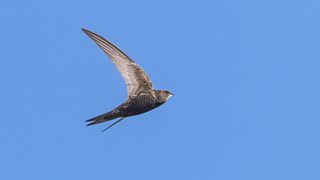
Swift, taken by Ben Porter
Friday evening
I pulled into Thetford station under a blazing hot sun on Friday afternoon, after a draining eight-hour journey from my university campus in Cornwall. After arriving at the weekend hub – BTO’s headquarters at the Nunnery – I spent an enjoyable time meeting the friendly BTO team and some of the attendants already on site. It was great to catch up with the familiar faces of keen young birders I already knew, whilst also meeting people who were somewhat newer to the exciting past-time of bird watching. We introduced ourselves whilst relaxing in the pleasant BTO garden, clocking up our first weekend wildlife species with Common Swifts screaming overhead and Song Thrushes stuttering out their song from nearby woodland.
After a delicious evening meal, we headed to our tents in anticipation of that quintessential element entailed in being a naturalist: ridiculously early starts!

Taken by Ben Porter
Ben M
Saturday Morning
We headed to the BTO’s Nunnery Lakes Reserve for a morning of bird ringing, nest recording and bird surveying. I assisted the nest recording session, finding nests for other Bird Camp participants to look at. Due to the spring conditions we had experienced over the past couple of months, there weren’t a great number of nests present, as birds had nested early. However, we did manage to find two Willow Warbler nests (both with chicks), a Gadwall nest and a Blackbird nest.
Ben P helped run the bird ringing session, which was very successful - all of the participants were able to take away several skills of how to carry out the ringing process, and also obtain close ID tips for some of the birds of the Nunnery Lakes. The birds ringed included Cetti’s Warbler, Sedge Warbler and a Song Thrush.
The third activity was a Common Bird Census (CBC), which taught the young birders to be able to not only ID birds by sight and song, but also plot territories on a map, and indicate how each bird was detected.
Whilst carrying out these activities, some good birds were spotted around the reserve, including a Stone Curlew and several Cuckoos!
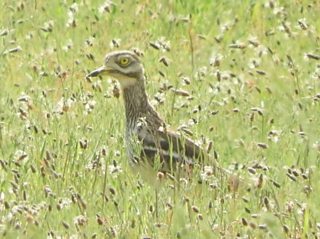
Stone curlew
Ben P
Saturday afternoon
After a brief stop to re-fuel ourselves and retreat from the intense midday sun, we bundled into the vans and headed off to RSPB’s . The reserve warden of the important conservation measures being implemented to encourage some of the rare species we’d come to see. Splitting into two groups, we then set out with the aim of a friendly bird race competition to see who could record the most species in our time there.
A blustery east wind meant most reed-dwelling songbirds were keeping their heads down, but this didn’t stop us attaining some brilliant spectacles: Marsh Harriers quartering back and forth above the reed beds, Hobbies powering overhead alongside scything Swifts, male Cuckoos cuckoo-ing in the Poplar Groves, Cetti’s Warblers exploding into song from willow stands, and even the star reserve birds: Bitterns and Bearded Tits giving great views. We also encountered Scarce Chaser dragonflies, Mother Shipton moths, Variable Damselflies and Hairy Hawkers in the sheltered ditches beside the waterways.
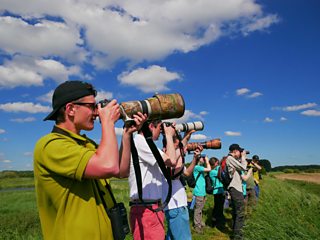
We could have spent all day enjoying the multitude of wildlife here, but had to skip off with a neck-to-neck tally of 55, and 56 bird species between our groups!
Saturday evening
Returning to the Nunnery for early evening, we were all whirring after the day’s events - but the day was far from over. Post-dinner, I gave a short talk about growing up on Bardsey Island and the role of in the long-term monitoring of bird populations. As the sun crept lower in the sky, we headed to Thetford forest in the hope of glimpsing an elusive forest-dweller. Willow Warblers, Yellowhammers and Tree Pipits were singing away as we set up three mist nets in the pines. We waited until dusk, when the colour had drained from a spectacular sunset, and it was now that the amazing churring song of male Nightjars broke the dead silence. We had come to try catch one as part of into their ecology and worrying declines. As if perching views and fly-by glimpses weren’t enough, our tape lures did the trick and enticed a male into one mist net, giving the whole group a very special view of this incredible species. I was over the moon to see one up close, taking in its amazing camouflage patterning, its huge night-vision eyes, long bill bristles and ridiculous gape size suited for pursuing night-time insects. What an end to our first day!
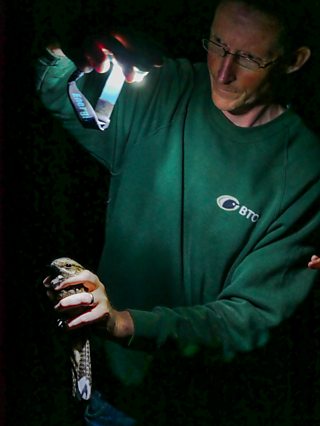
Ben M
Sunday Morning
Sunday morning saw an early morning visit to Landguard Bird Observatory, where we were greeted by warden Nigel Odin. After some history and background of the site, Nigel opened up the reserve moth trap, and all of the campers were able to obtain close up views of some very special moths. Highlights included Cream Spot Tiger, Small Elephant Hawkmoth, Poplar Hawkmoth and a site first – Beautiful Hooktip!
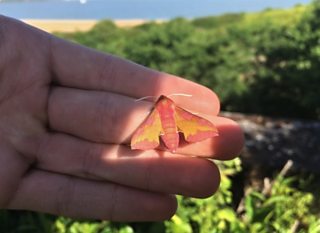
Small elephant hawkmoth
After looking at the moths, we were guided around the reserve, where everyone obtained excellent views of the local Ringed Plovers with young, which were the undoubted highlight bird wise around the reserve.
A drive further north up the Suffolk Coast took us to the area of Hollesley, and firstly, to Upper Hollesley Common. Here, I led the group to try and find Dartford Warbler, Woodlark and Stonechat, all speciality species of the area. After a lot of patience, we hadn’t found a Dartford Warbler, but had had excellent views of Stonechat and a singing Woodlark, and even a bonus Yellow Wagtail flyover! A little later however, a Dartford was spotted just on the other side of the heath! We all ran over and were greeted to great, albeit brief, views of a male Dartford Warbler!
Ben P
Sunday afternoon
Our luck with the stunning weather continued into our second afternoon, which saw us at yet another superb Suffolk site: namely the RSPB’s . This coastal area of wetlands and shallow pools is important for a range of migrant and passage waders such as the charismatic Pied Avocet and Lapwing. We spent an enjoyable afternoon here, enjoying fantastic views of the breeding Avocets, calling incessantly as they harried passing crows and harriers; Lapwings displayed over the damp meadows, Common Terns fished offshore, two adult Mediterranean gulls drifted overhead, and a variety of wildfowl and waders offered a good opportunity to test ID skills. It was particularly exciting to see Red-veined Darters as we walked around – a scarce visitor from the continent that is rarely seen here.
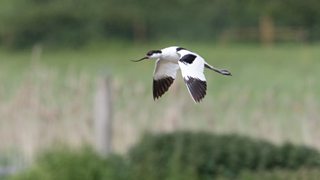
Avocet
After appreciating some excellent shorebird action and feeling the previous 48 hours catching up with us all, it was time to head back north to Thetford. Thus marked the end of the 2017 Bird Camp – a weekend packed full of amazing birds, fantastic places, engaging activities and a group of young birders I feel privileged to have spent time getting to know. A massive thank you to the BTO for organizing this brilliant event, the Cameron Bespolka Trust for funding it, and to all the team and other young volunteers that made for such an enjoyable weekend. Until next year!